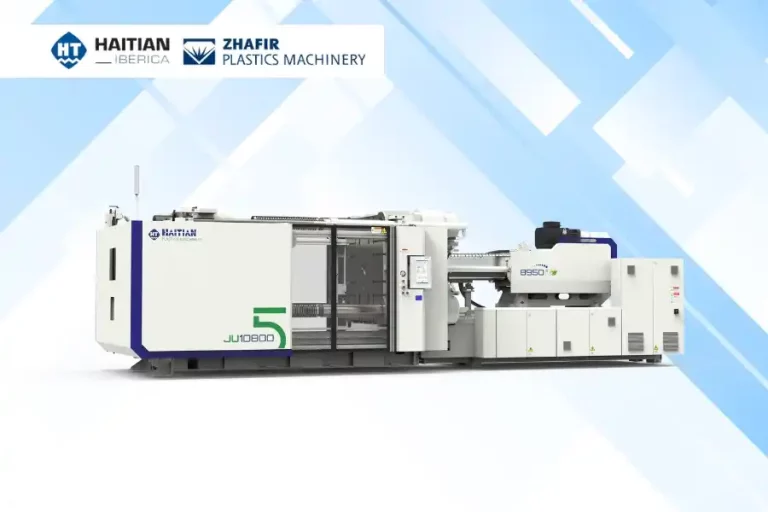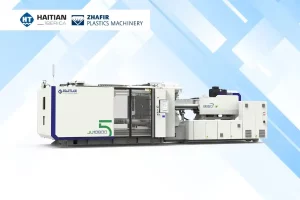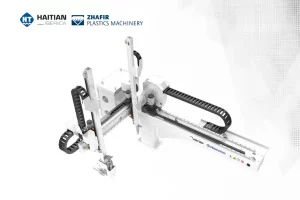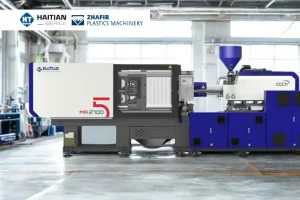Plastic injection molding machines are essential equipment for transforming polymers into finished products. Their role in sectors such as automotive, electronics, packaging, or medical devices is key to maintaining efficient, precise, and high-volume production. Choosing the right machine can make a significant difference in quality, speed, and profitability.
In this article, you’ll discover what they are, how they work, and what criteria to consider when investing in an injection molding machine. Additionally, you’ll learn about the differences between types of injection machines and the advantages each offers depending on your production needs.
What are plastic injection molding machines and how do they work?
Main components of an injection molding machine
A plastic injection molding machine consists of two main units: the injection unit and the clamping unit. The first is responsible for melting the plastic and delivering it to the mold, while the second ensures the mold remains closed under pressure during filling and cooling.
Other essential components include the plasticizing screw, which heats and transports the polymer, and the control system, which regulates parameters such as pressure, speed, and temperature. Modern injection machines also feature touchscreen interfaces with smart software that optimizes cycles and allows real-time adjustments.
Thanks to this configuration, automated, precise production is achieved, adaptable to various types of molds and materials.
Stages of the injection molding process
The molding cycle consists of several synchronized phases. The plastic, usually in pellet form, is introduced into the hopper and passes into the heated barrel, where the screw melts it. The molten material is then injected into the mold, where it takes the desired shape.
Injection and mold filling
In this phase, the screw acts as a plunger, pushing the molten material into the mold cavity at high pressure. The goal is to fill the mold quickly and uniformly, avoiding bubbles or defects. This step must be carefully controlled to ensure that pressure and temperature are optimal according to the type of material used.
Cooling and part ejection
Once the mold is filled, the plastic cools and solidifies. The cooling time depends on the volume and geometry of the part. Once the required rigidity is achieved, the mold opens and an ejection system releases the part. The cycle then restarts with the next dose of material. The complete cycle time can vary between 10 and 60 seconds, depending on the part size and the type of machine.
How to choose the ideal plastic injection molding machine for your production
Key factors depending on the industry and final product
Not all injection machines are suitable for every product. It’s essential to consider part size, type of plastic, production volume, and required precision. For example, the medical industry requires strict tolerances, while in consumer goods efficiency and speed are prioritized.
The main factors to evaluate are:
- Clamping force (kN): prevents the mold from opening under pressure.
- Injection volume (cm³): determines the maximum part size.
- Injection speed: affects cycle time and surface quality.
- Energy efficiency: key to reducing operational costs.
- Automation compatibility: for integration into robotic production lines.
It’s also advisable to work with manufacturers that offer technical support and spare part availability to ensure continuous machine operation.
Types of injection machines and their advantages
Electric vs. hydraulic injection machines
Hydraulic machines are more affordable and provide high clamping force, making them suitable for large and robust parts. However, they consume more energy and require frequent maintenance. On the other hand, electric machines are more precise, faster, and energy-efficient. They are ideal for small, technical parts or those requiring high repeatability.
According to Plastics Today, electric injection machines consume up to 50% less energy than traditional hydraulic ones, representing significant long-term savings. Additionally, by eliminating hydraulic oil, the risk of contamination in medical or food applications is reduced.
Hybrid technology: efficiency and precision
Hybrid injection machines combine the best of both worlds: the power of hydraulics with the efficiency of electrics. They use electric motors for functions requiring precision (such as injection) and hydraulic systems for movements requiring force (such as clamping).
This type of machine is ideal for versatile production lines that need to adapt to different types of parts. They also allow customizations and offer closed-loop injection control, which improves cycle stability and reduces the margin of error.
Find the ideal plastic injection molding machine at Haitian Ibérica
Investing in the right plastic injection machines helps optimize resources, improve final product quality, and increase competitiveness in demanding markets. Understanding how they work and what technical features to assess is key to making informed decisions.
If you’re considering modernizing your equipment or expanding your production line, don’t hesitate to contact us. The performance of your factory largely depends on the reliability and efficiency of the technologies you use. Modern injection molding machines are the foundation for profitable, sustainable, and high-precision production.





